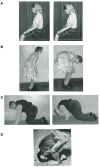Trunk orientation, stability, and quadrupedalism
- PMID: 23504009
- PMCID: PMC3596858
- DOI: 10.3389/fneur.2013.00020
Trunk orientation, stability, and quadrupedalism
Abstract
Interesting cases of human quadrupedalism described by Tan and Colleagues (2005-2012) have attracted the attention of geneticists, neurologists, and anthropologists. Since his first publications in 2005, the main attention has focused on the genetic aspects of disorders that lead to quadrupedalism within an evolutionary framework. In recent years this area has undergone a convincing critique (Downey, 2010) and ended with a call "… to move in a different direction … away from thinking solely in terms of genetic abnormality and evolutionary atavism." We consider quadrupedalism as a "natural experiment" that may contribute to our knowledge of the physiological mechanisms underlying our balance system and our tendency toward normal (upright) posture. Bipedalism necessitates a number of characteristics that distinguish us from our ancestors and present-day mammals, including: size and shape of the bones of the foot, structure of the axial and proximal musculature, and the orientation of the human body and head. In this review we address the results of experimental studies on the mechanisms that stabilize the body in healthy people, as well as how these mechanisms may be disturbed in various forms of clinical pathology. These disturbances are related primarily to automatic rather than voluntary control of posture and suggest that human quadrupedalism is a behavior that can result from adaptive processes triggered by disorders in postural tone and environmental cues. These results will serve as a starting point for comparing and contrasting bi- and quadrupedalism.
Keywords: bipedalism and quadrupedalism; gait pathology; humans; locomotion; muscle tone; posture control.
Figures


Similar articles
-
Ground reaction forces and center of mass mechanics of bipedal capuchin monkeys: implications for the evolution of human bipedalism.Am J Phys Anthropol. 2013 Jan;150(1):76-86. doi: 10.1002/ajpa.22176. Epub 2012 Nov 2. Am J Phys Anthropol. 2013. PMID: 23124531
-
Two families with quadrupedalism, mental retardation, no speech, and infantile hypotonia (Uner Tan Syndrome Type-II); a novel theory for the evolutionary emergence of human bipedalism.Front Neurosci. 2014 Apr 22;8:84. doi: 10.3389/fnins.2014.00084. eCollection 2014. Front Neurosci. 2014. PMID: 24795558 Free PMC article. Review.
-
Forelimb muscle and joint actions in Archosauria: insights from Crocodylus johnstoni (Pseudosuchia) and Mussaurus patagonicus (Sauropodomorpha).PeerJ. 2017 Nov 24;5:e3976. doi: 10.7717/peerj.3976. eCollection 2017. PeerJ. 2017. PMID: 29188140 Free PMC article.
-
Uner tan syndrome: history, clinical evaluations, genetics, and the dynamics of human quadrupedalism.Open Neurol J. 2010 Jul 16;4:78-89. doi: 10.2174/1874205X01004010078. Open Neurol J. 2010. PMID: 21258577 Free PMC article.
-
Insights into the evolution of human bipedalism from experimental studies of humans and other primates.J Exp Biol. 2003 May;206(Pt 9):1437-48. doi: 10.1242/jeb.00279. J Exp Biol. 2003. PMID: 12654883 Review.
Cited by
-
The Influence of Dental Occlusion on Dynamic Balance and Muscular Tone.Front Physiol. 2020 Jan 31;10:1626. doi: 10.3389/fphys.2019.01626. eCollection 2019. Front Physiol. 2020. PMID: 32082183 Free PMC article.
-
Immature Spinal Locomotor Output in Children with Cerebral Palsy.Front Physiol. 2016 Oct 25;7:478. doi: 10.3389/fphys.2016.00478. eCollection 2016. Front Physiol. 2016. PMID: 27826251 Free PMC article.
-
Haptic communication and interpersonal dynamics in hand-by-hand guided locomotion in children and adults.Front Bioeng Biotechnol. 2025 Aug 11;13:1622083. doi: 10.3389/fbioe.2025.1622083. eCollection 2025. Front Bioeng Biotechnol. 2025. PMID: 40861860 Free PMC article.
-
Two Sides of the Same Coin: Tendoligamentous Similarities and Dissimilarities of Great Toe and Thumb Anatomy on MRI.Indian J Radiol Imaging. 2022 Apr 19;32(1):113-123. doi: 10.1055/s-0042-1743114. eCollection 2022 Mar. Indian J Radiol Imaging. 2022. PMID: 35722646 Free PMC article.
-
Locomotor-like leg movements evoked by rhythmic arm movements in humans.PLoS One. 2014 Mar 7;9(3):e90775. doi: 10.1371/journal.pone.0090775. eCollection 2014. PLoS One. 2014. PMID: 24608249 Free PMC article. Clinical Trial.
References
-
- Downey G. (2010). Human, quadruped: uner Tan syndrome, part 1. Available at: http://blogs.plos.org/neuroanthropology/2010/09/03/human-quadruped-uner-...
LinkOut - more resources
Full Text Sources
Other Literature Sources
Miscellaneous

